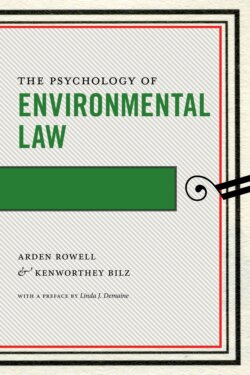Читать книгу The Psychology of Environmental Law - Arden Rowell - Страница 8
На сайте Литреса книга снята с продажи.
Preface
ОглавлениеLinda J. Demaine
The NYU Press Psychology and the Law book series addresses an intriguing state of affairs in legal scholarship. Although law and legal process are inherently psychological in nature, traditionally, relatively few law professors, judges, or legal practitioners have drawn on empirical psychological research to inform their perspectives and decisions. In recent years, the legal community has increasingly recognized that both substantive law and legal procedure rest on a multitude of testable assumptions about human behavior that can be informed by psychological research. Without formal training in psychology, however, it can be challenging for legal experts to identify relevant and informative psychological research, evaluate its methodological rigor, and interpret the empirical results. Consequently, in the absence of trusted resources to translate findings from psychological studies and apply them to core legal issues, psychology’s potential to inform legal doctrine and practice will remain unfulfilled. Lawyers, in particular, will lack the tools that would enable them to better understand the law’s effects on human behavior and how the law might be better constructed to achieve its goals.
Three important exceptions to psychology’s peripheral status in legal scholarship are eyewitness testimony, false confessions, and jury decision making. In each of these realms, insights from psychological research have entered legal discussions and debates, resulting in marked improvements in the legal system’s functioning. These exceptions, which developed precisely because lawyers communicated the fundamental legal issues to psychologists and psychologists introduced lawyers to informative research findings, demonstrate the potential of psychology to inform the law.
The Psychology and the Law book series is intended to help make the exceptions into the rule by expanding and strengthening the intersection of law and psychology. To achieve this goal, the series applies psychology to subjects covered in the core law school curriculum. The books are designed to facilitate exchanges between lawyers and psychologists about these fundamental legal issues by introducing lawyers to the most pertinent research methods and findings and introducing psychologists to the most central and generally complex legal issues. The books are valuable assets for law professors who desire to incorporate psychological science into their classes. To facilitate their adoption in law classrooms, the books map onto popular casebooks and are relatively brief and practical. The books are also prime resources for participants in psychology-law graduate programs, professors who teach undergraduate law and psychology courses, and mainstream psychologists who study legal issues. The books’ expansive coverage of psychological research on core legal topics and their identification of areas in need of further research will provide these audiences with current knowledge and a roadmap to inspire empirical study. Finally, the books will be useful to legal practitioners whose work in particular areas of law can benefit from an understanding of psychology. All volumes are authored by eminent scholars who are conversant in both psychology and the law and possess the expertise necessary to identify and articulate legal issues of import, apply psychological theory and research findings to them, and identify areas of future research for psychologists.
In The Psychology of Environmental Law, Rowell and Bilz employ psychological science to explain and critique key facets of environmental law. Since its inception, environmental legal analysis has been dominated by an economic perspective. Although informative, economics provides an incomplete understanding of environmental law’s goals, processes, and consequences, as these are inherently psychological in important respects. Rowell and Bilz thus take a groundbreaking approach to environmental law in this volume, elevating the field through a more nuanced, realistic view of environmentally impactive human behavior and its driving forces.
The first part of the book is designed to equip readers to engage in independent psychological analysis of environmental law. To this end, Rowell and Bilz initially identify three defining features of the psychology of environmental injuries: 1) diffusion through time and space unseen in other types of legally recognized injuries; 2) complexity in terms of their interactions with other human behaviors, their nonlinearity in impacts, and their multicausality; and 3) an important nonhuman element insofar as environmental injuries interact with nonhuman natural processes and implicate nonhuman stakeholders. These features are essential to considering how human behaviors are likely to affect the environment and to the law’s ability to use humans as intermediaries to shape the environment in desired ways. After explaining the relevance of each defining feature, Rowell and Bilz discuss several empirically tested psychological concepts—including cognitive dissonance, loss aversion, the endowment effect, the status quo bias, and the availability heuristic—that underlie them. These studies investigate the concepts in a variety of settings with resulting, sometimes counterintuitive, changes to participants’ behavior. In the aggregate, the studies provide versatile, powerful tools for understanding the causes of harmful human environmental impacts and fostering positive change.
Rowell and Bilz then illustrate how such a psychologically driven environmental analysis might be carried out, describing applications to classic problems in environmental law in the subfields of pollution control, ecosystem management, and climate change. Such problems, they argue, can be more effectively addressed with an understanding of the motivations, biases, and other psychological phenomena that underlie people’s interactions with the environment and their evaluations of environmental injury.
By drawing upon the rich offerings of psychology, Rowell and Bilz expertly inform government efforts to regulate the most far-reaching aspects of human behavior—those that impact the natural environment in which we live and on which we rely so greatly for sustenance. They end the volume by forging a promising path for future psychological analysis of environmental law.
